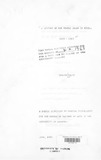| dc.description.abstract | This thesis is a survey of the economic, socio-cultural and political life of the Yemeni Arabs in Kenya during the Colonial Period, 1895 - 1963. The Yemeni Arabs are a fairly distinct group of Arabs who migrated from Southern Arabia. The term Yemeni or Yemeni Arabs in this study will be used to refer to those people who came from both the Yemens - the present day People's Democratic Republic of South Yemen and the Republic of North Yemen. However, when direct reference is made to those Yemenis who came from Hadhramaut in South Yemen, they will be referred to as Hadhramis.
There has been very long-established relations between the East African coast and South Arabia. The East African coast was visited by people from the Southern Arabian coast from pre-lslamic times. Traders plied the Indian Ocean, the Arabian Sea and the East African coast in search of trading commodities before the birth of Islam. With the advent and spread of Islam, and subsequent settlement of Muslims on the East African littoral, Islam was introduced into the region. By the 14th century, as the rapid commercial, immigration and cross-cultural contacts between the two regions intensified, a "civilization" was born on the East African coast when the Yemenis contributed significantly. Although the Portuguese disrupted this development, Mombasa and Pate became new centres of commerce, trade, Swahili civilization, coastal Islam and resistance to the Portuguese.
With the Busaidi restoring peace in the Indian Ocean, with the help of the British, the Yemeni Arab permanent settlement in East Africa increased. They were employed in the Sultan's services in commerce and in manual labour, so that by the 19th Century, the Yemenis formed an important section of the Arab population along the coast of East Africa.
The Hadhrami sharifs played an important role in the spread of Islam in East Africa. Islam spread into the interior from the coast with a predominance of the Shafii madhab in all the religious ceremonies and rituals, in spite of the fact that there was a large settlement of Ibadis from Oman as a ruling class. As the Yemenis migrated and settled in East Africa, they brought along with them their social and cultural values. They tried to preserve a distinct cultural identity, by maintaining strong ties with their homelands. Their conservativeness helped to preserve and cement these values and identity.
However, with the advent of colonialism after 1895, and through the process of assimilation and cultural interaction with the local communities at the coast, the Yemenis experienced a degree of social change. But the large influx of a labour-migrant class from Hadhramaut at the turn of the century, helped maintain their socio-cultural values. The Hadhramis have maintained a distinct cultural identity over the centuries, especially in wedding ceremonies, music, dance, dress and preservation of Arabic.
Colonialism brought modern western values which not only affected the Yemeni community, but the entire Arab and Swahili population at the coast, so that by the 1960's, although still distinct in some aspects, the Yemenis had come to terms with western education and a significant degree of modernisation in general.
During the Colonial period, the Yemenis became an important economic factor in the commercial and economic activity of the country. They managed to represent a competition to the Indian traders and embarked into more sophisticated and lucrative economic and commercial activities, such as transport, export and import trade. The earlier labour-migrant Yemeni Arabs had come in search of a better life in East Africa and were attracted to Mombasa because of new opportunities, thus becoming an important labour force In the port. Their lack of hobbies, very modest life-style and high degree of thriftiness and industry enabled them to compete with the more sophisticated Indian traders. Lack of capital in the early years of colonial rule prevented them from embarking into more ambitious enterprises. However, their high propensity to save later contributed towards capital formation and enabled them to venture into more lucrative economic and commercial sectors of the economy of the country.
The Yemenis remained apolitical for long. They were not actively involved in local politics till after the Second World War. As the Yemeni had come in search of a better life, he was more concerned with the local tribal, social organizations or associations which had evolved in order to cater for the basic needs of the new immigrant. These jumiyas worked as social-welfare organizations, thus acting as a barrier to their involvement in national politics. The Yemenis were content to be led by their Mugaddams, traditional leaders, who were also recognised by the colonial authority, as such.
However, as more of their youth attended secular schools and interacted with other communities at the coast, they became more and more politically aware and, thus, involved in local politics. During the Mwambao episode at the coast, when Kenya was fighting for her political independence, the Yemeni Arabs were caught in the political wind of the time. There were those who believed that as a predominantly migrant community, they should not get involved in the local politics, while there were some who felt that they could not remain as on-lookers, since they were locally born and knew no other home save Kenya.
The study ends with an appraisal of the status of the Yemenis in post-independent Kenya. | en |

